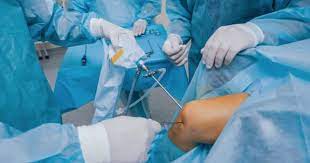Certainly! Partial and total knee replacement surgeries are two different approaches to treating knee joint damage, typically caused by conditions like osteoarthritis. Here are the key differences between the two:
Partial Knee Replacement (PKR)
Scope of Surgery
- Unicompartmental Approach: Partial knee replacement, also known as unicompartmental knee arthroplasty, involves replacing only the damaged compartment of the knee. The knee has three compartments: medial (inner), lateral (outer), and patellofemoral (front, between the kneecap and thigh bone). PKR targets only the affected compartment.
Indications
- Localized Damage: This surgery is indicated when damage is confined to one compartment, and the remaining knee joint structures (like ligaments and other compartments) are healthy.
Procedure
- Selective Replacement: The surgeon removes the damaged cartilage and bone from the affected compartment and replaces them with metal and plastic components.
Recovery and Outcome
- Less Invasive: PKR involves a smaller incision and less bone removal, preserving more of the natural knee structure.
- Quicker Recovery: Generally, recovery time is shorter compared to total knee replacement. Patients often experience less pain postoperatively and regain function more quickly.
- Natural Motion: PKR tends to preserve more of the knee’s natural motion and potentially offers a more natural feel compared to total knee replacement.
- Longevity: PKR may not last as long as a total knee replacement, especially if arthritis progresses to other compartments.
Total Knee Replacement (TKR)
Scope of Surgery
- Complete Joint Replacement: Total knee replacement, also known as total knee arthroplasty, involves replacing the entire knee joint, including all three compartments.
Indications
- Extensive Damage: This surgery is indicated for patients with widespread arthritis or damage in more than one compartment of the knee. It is also considered when there is significant pain, stiffness, and functional impairment that affects daily activities.
Procedure
- Comprehensive Replacement: The surgeon removes the damaged cartilage and bone from the surfaces of the thigh bone (femur), shin bone (tibia), and sometimes the kneecap (patella). These surfaces are then replaced with metal and plastic components to create a new joint surface.
Recovery and Outcome
- More Invasive: TKR is a more extensive procedure involving a larger incision and more bone removal.
- Longer Recovery: Recovery time is typically longer compared to partial knee replacement. Rehabilitation and physical therapy are crucial for restoring function and strength.
- Functional Restoration: While TKR restores joint function, some patients may feel the knee is less natural compared to PKR.
- Durability: TKR typically has a longer lifespan than PKR, often lasting 15-20 years or more, depending on activity level and overall health.
Decision Factors
Extent of Joint Damage
- Localized vs. Widespread: If damage is limited to one compartment, PKR may be suitable. Extensive damage across multiple compartments typically necessitates TKR.
Patient Age and Activity Level
- Younger, Active Patients: Younger, more active patients might benefit from PKR due to its preservation of knee structure and quicker recovery. Older patients or those with more severe arthritis might be better candidates for TKR.
Overall Knee Health
- Ligament Integrity: The integrity of ligaments, particularly the anterior cruciate ligament (ACL), is crucial for PKR. TKR can be performed regardless of ACL condition.
Summary
Both partial and total knee replacements have high success rates and can significantly improve the quality of life for patients with debilitating knee pain and dysfunction. The decision between the two should be made in consultation with an orthopedic surgeon, considering individual circumstances, the extent of joint damage, and the patient’s overall health and lifestyle.





Comments